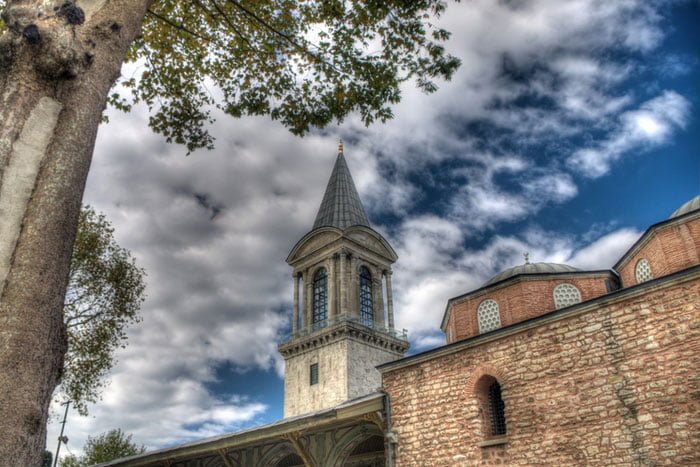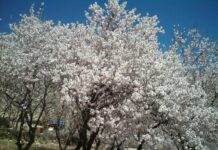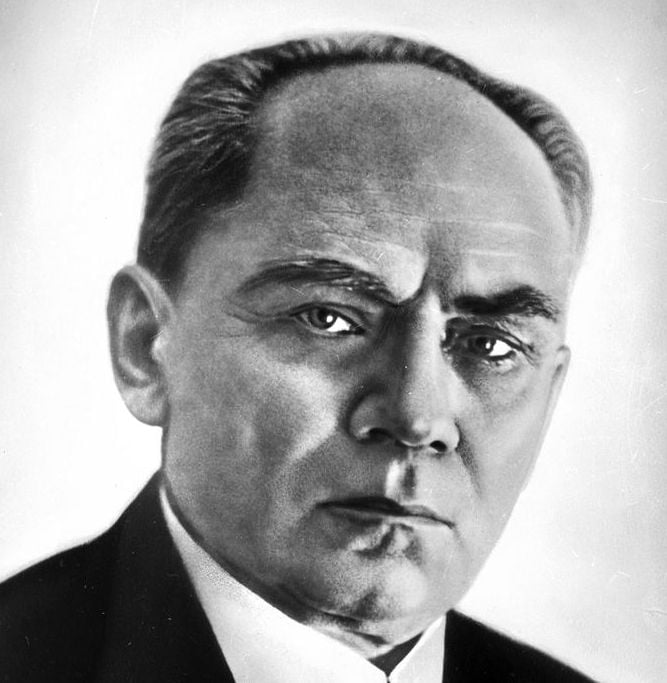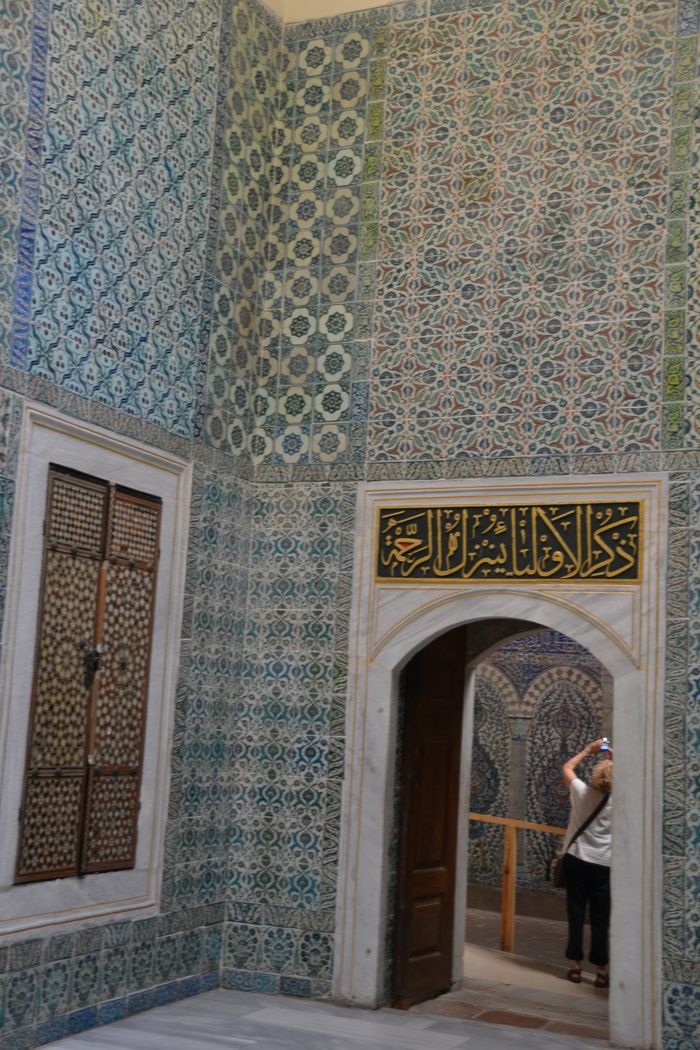The famous Ottoman historian Evliya Celebi describes the Topkapi Palace (Topkapi Sarayi) as “the loveliest sultanate palace that human skill could have created. One can not help doing anything but ruling if living in here! If you can come out of this complex game that is made of terraces, corridors, stairs and interior courts; you find yourself in the world of Arabian Nights again. The palace once Ottoman Sultans lived is visited by thousands of visitors from all parts of the world, is the most splendid monument of Istanbul.
The palace had a concept peculiar to the East, accommodating several qualities in it: The residence of the Sultan and the center of a world empire, the religious center of half of the world and the stage that incredible intrigues displayed, the focus of cruel murders and the cradle of breathtaking successes. Once, 4,000-5,000 people used to live in Topkapi Palace. This was a city in the city. Fatih Sultan Mehmet decided to have a vast palace built to the ridges of old Byzantium Acropolis.
The reason Sultan Mehmet chose this place was not only the beauty of the ridges. He was planning to have a residential fortress built where Istanbul could be protected best. A high city wall, extending from Golden Horn as far as the Sea of Marmara, separating Topkapi Palace from the rest of the city. The Byzantium walls, beginning from the corner of the palace and stretching to Theodosian Walls through the shores of Marmara were protective against a possible sea attack.
The First Court
This front court that is connected to the main entrance with Bab-i Humayun (the Imperial Gate), once the Janissaries used to accommodate, serves as the parking area for the buses and cars bringing thousands of visitors today. On the left are Defterdar Dairesi (the Financial Department) and ig Cephane (the Interior Arsenal, the former Haghia Eirene Church); while the Archaeological Museum and Cinili Kosk (the Tiled Pavilion) that Mehmet U had built are located at the back.
The Second Court
The entrance to the palace is through the next gate, Bab-us Selam. Everybody had to get off his horse at this gate, but the Sultan since he was the only authorised one to pass through this gate on horse. When the foreign ambassadors would be welcomed, this court used to be crowded by the notables of the empire, the Janissaries and court guards used to gather here with their showy costumes.
The participants of these welcoming ceremonies could be up to 10,000 and the foreign guests mostly expressed their bewilderment against the silence that was dominant during the ceremonies. In the court, visited by thousands of people today, once gazelles, deers, goats and peacocks used to stroll under the cypress trees.
This court, the garden of silence and peace, and where the great and carefully planned ceremonies took place, used to reflect the spirit of the empire. The Divan (council of the state) used to gather at Kubbealti on the left. This domed, rectangular, plain place has low sofas (“divan”, in Turkish) covered with carpets, extending along with the walls in three sides of it.
The legendary grilled window above the Grand Vezir`s place is still there, the Sultan used to watch the discussions in Divan behind this window. Generally, the Divan used to gather four times between Sunday and Tuesday, and all sort of decisions relevant to administration were taken here. Orders were given, feudal fiets (timar) were delivered, complaints were listened, the decrees (firmans) were signed and the negotiations with the foreign ambassadors; all these used to take place here in Divan.
It was easy to understand the status of the officials and notables by looking at the arm shape and colour of their costumes or even linings, the fur, but first of all the turban and the style of their beard. The vezirs used to wear green, muftis white, mullahs light blue and ulema purple; while the ones relating to the court used to be distinguished by their red costumes, the colour of sheikhs was blue. Across Divan, the East of the second court, were the Dolap Ocagi and the kitchens. Meal for the ones living in the palace, which means thousands of people, was cooked here. It was one of the important porcelain collections of the world due to the variety of kitchen tools made of Chinese, Japanese and European porcelains as well as copper pots, bowls and cups.
Behind the third gate, Bab- tis-Saadet, was the Throne Room (Arz Odasi) where the Sultan waited for notables, ambassadors and foreign guests. In this room, furnished Ottoman/Turkish style, the Sultan used to accept his visitors sitting on showy pillows and precious carpets. The world beyond it, Enderun, was close for them too.
It will be helpful to see some part of the Harem before going this section. Harem was directed with strict rules and great care, and this director was never a man, it was the mother of the ruling Sultan, Valide Sultan. As a concept, Harem means the forbidden or holy place. There were many women slaves and eunuches in Harem along with the women taken into by the Sultan for their beauty. The most powerful one in the Harem was the Kizlar Agasi. That was the third important person of the Ottoman Empire, after the Grand Vezir and Sheikhulislam.
The Third Court
The walk in the Harem ends at its actual entrance in the Third Court. This lovely building, built in the 18th century is The Library of Ahmet III. The buildings that are arranged in an order where the thrones, valuable costumes, ornamented weapons, miniatures and the legendary treasures of the Sultans are exhibited today used to be the palace school. This school was probably the most important official institution of the East and one of the best educational institutions that survived in a feudal system. 48 of the 60 Grand Vezirs whose lives are well known were educated here, including four vezirs of Suleyman the Magnificent. The costume collection of the Sultan can be seen in the Turkish bath located to the East of the Third Court: Turkish fabrics woven of silk and artificial fiber, silk caftans, the Sultan`s garments and precious prayer rugs. In the four rooms of the world famous Treasury, also the first residence of Fatih Sultan Mehmet in Topkapi Palace, the legendary treasures that were collected by Ottoman Sultans for centuries are exhibited.
Helmets, daggers, the candlesticks made for the tomb of Prophet Mohammed and also an elephant-shaped play box made of gold are exhibited in the first room. In the second room is the famous Topkapi Dagger that has three emerald stones as well 12 big and 124 small diamonds on its handle; this dagger has become world famous after the movie that Melina Mercouri performs a skillful burglar. In the third room is the biggest emerald of the world, and the Harem, a separate world isolated from the rest of the palace, was composed of corridors, secondary courts, small gardens, stairs and various places around 300 in total.
Kasikci Elmasi (The Spoonmaker`s Diamond) that is 86 carats and ornamented with 49 diamonds. The name of the diamond comes from the incident that it was bought by a junk dealer in charge of three wooden spoons in the 17™ century. Each of the two candlesticks made of pure gold and weighs 49 kilograms and has 6666 diamonds.
Sultan Abdulmecit had them made for Kaaba at Mecca. The gold plated throne that is decorated with 954 emerald and ruby stones, is the one the Sultans used to sit during their admissions in Bab-us Saadet. The passage to the fourth room is through a terrace with a perfect view of the Sea of Marmara. A part of the Iran and Turkish miniature collection that has very much importance in terms of history of art, is exhibited in the building next to the Fourth Court.
The Turkish miniature art was at its peak in the 1sthand 161`1 century. The volumes of manuscripts were decorated with flowers, buds, the sky, clouds and people. The variety in the way that the nature, animals, rocks and architecture, drawings and the usage of gold are the indicator that these creations were made by several artists.
Although the Turkish miniatures look like Iranian and Arab miniatures at the first glimpse, generally they reflect the daily life; and it is possible to come across with the traces of romanticism and decorative examples. There is partial perspective in the miniatures as well as no lighting and shading. The remains of the holy Muslim personalities are exhibited in Hirka-i Saadet dairesi. The overcoat, a piece of beard, flag and sword of the Prophet as well as the sword of the first four caliphs Abu Bekr, Umar, Othman and Ali are here. Also, the holy objects from Mecca are here: The keys and locks of Kaaba, the solid gold covering for the black Hacer ul-Esved stone that is holy for the Muslims.
The Fourth Court
In the adjacent garden stepping down in form of terraces are the fountains, Revan Koskui636), Bagdat Kosku (1639), an arbor from 1641 and Sofa Kosku from 18th century. Ending the visit to the Saray at the terrace of Mecidiye Kosku or at Teras Cafe at its lower floor. You can enjoy the wonderful panorama here.
Open between 9.30 AM – 5 PM everyday except Tuesday.
Read More about Grand Balkan Tour








